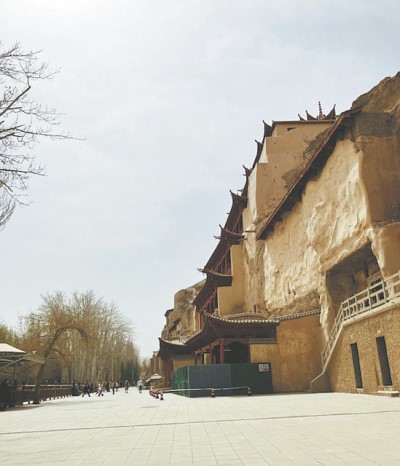Desert town in China retains old India link

The Mogao Grottoes, a UNESCO World Heritage Site, in Dunhuang. [Photo by Satarupa Bhattacharjya/China Daily]
A desert town is perhaps the most prominent among locations in China that still reflect its links with India in ancient times.
Dunhuang in today's Gansu province in northwestern China, where a trove of Buddhist artwork was created over centuries (fourth to 14th), tells that story.
The town, on the fringes of the Gobi, shows other signs of the confluence of cultures, including Islamic. It was a military garrison during the Han Dynasty (206 BC-AD 220), with the Crescent Moon Lake — a blue-and-green patch amid the "singing dunes" of sand that appear beige or gray, depending on the time of day or night — serving as an oasis for trader caravans. Bactrian camels are sighted there as part of present-day tourism.
But the area's top draw, the Mogao Grottoes, a UNESCO World Heritage Site, built on mounds and painted with thousands of Buddha figures, including sculptures, in soft pigment and mineral colors across some 45,000 square meters of wall space, reveals the extent of the Indian connection.
The 492 preserved caves, once home to meditating monks, stretch 1,600 meters long by the dry Dachuan River.
The arrival of Buddhism in China from India is illustrated: One mural depicts Emperor Ashoka, who sent his emissaries to promote the religion in Asia, praying beside a stupa. The seventh-century artwork was given a touch-up during the Qing Dynasty (1644-1911), tour guide Li Yaping told me on a recent visit.
The Qing era saw more repairs but not all followed the original color schemes. The site's preservation is overseen by Dunhuang Academy over the past decades.
The Tang Dynasty (618-907), heyday of the arts and crafts in imperial China, backed the Sinicization of Buddhism. Mogao witnessed the changes, Li said.





 Print
Print Mail
Mail
